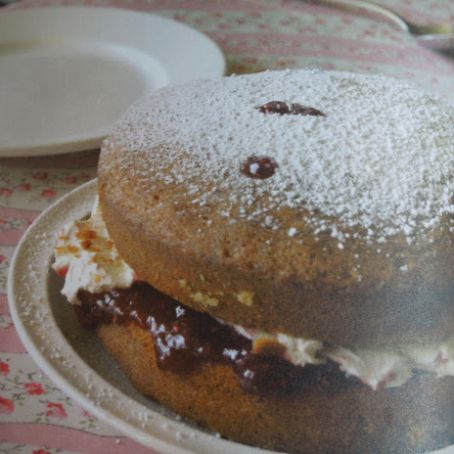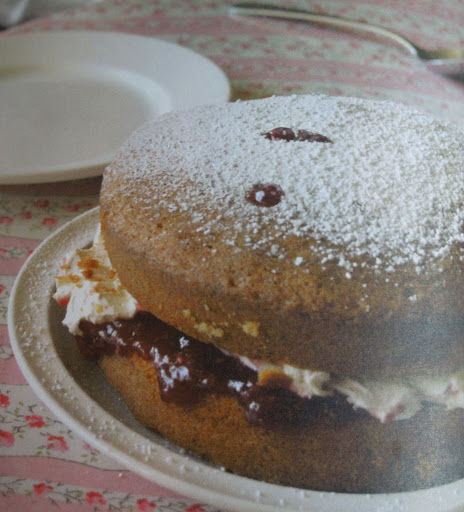Victoria Sponge Cake
By DeBruynC1
Victoria sponges are always made with equal quantities of butter, sugar, flour and eggs. If you look down the ingredients list below, you can see that there are no measurements given in this recipe. Instead, weight the eggs together in their shells on the scales and whatever the total weight, use the same weight of butter, of sugar and of flour. So if your four eggs weight 270 g, then use 270 g of butter, 270 g of sugar and 270 g of flour.
Our recipe tells you how to make a Victoria sponge the old-fashioned way - mixing all the ingredients by hand. But you can make a nearly-as-good version in an electric mixer.
 1 Picture
1 Picture
Ingredients
- make a 20cm cake:
- Free-range eggs, 4
- Unsalted butter - softened but not melted
- Caster sugar
- Self-raising flour
- pinch A pinch of salt
- Natural vanilla extract, 1 teaspoon
- A little milk, if needed
- Good jam (raspberry or your favourite), about 4good tablespoons
- Caster or icing sugar for dusting the top of the cake
- Two Two 20cm sandwich cake tins, baking parchment paper, pencil, scissors, large mixing bowl, wooden spoon, medium bowl, sieve, teaspoon, tablespoon, knife, wire cooling rack
Details
Adapted from google.co.uk
Preparation
Step 1
1. Set the oven to 180C/Gas Mark 4 and position a shelf in the centre of the oven. Grease the cake tins carefully with a scrap of butter on some kitchen paper. Stand a tin on the baking parchment and draw round the base. Cut out the circle and use this to line the base of the tin. Repeat for the other tin, then put both tins to one side.
2. Stand all eggs (still in their shells) on the weighting scales and make a note of their total weight. Put the eggs to one side.
3. Weight out the same amount of butter and put it in the mixing bowl. Using the back of the wooden spoon, beat-or'cream'-it until very soft. Weight out the caster sugar and add it to the butter a third at a time, beating with the wooden spoon to blend the butter and sugar together. After a little while, you'll notice that the mixture becomes quite fluffy. And if it doesn't, you should keep going until it does!
4. Weight out the flour, add the pinch of salt to it and set aside.
5. Break one of the eggs into the butter mixture and beat it quite hard until it is completely blended. Add the other eggs in the same way, one at a time. Sift in a tablespoon of the flour with the last egg; this will help stop the mixture curdling as you beat the egg in. Stir in the vanilla extract.
6. Set the sieve over the mixing bowl and tip all the flour into the sieve. Shake it all gently into the bowl.
7. With the tablespoon, start to 'fold' the flour into the cake mixture, using an up-and-over turn of the spoon like a paddle.
8. When the flour has been folded in, test the consistency of the mixture - whether it's stiff or sloppy. Scoop up a tablespoon of mix and turn it upside down over the bowl. If it drops down reasonably easily, then the mix is just right. If it sits stubbornly in the spoon, fold in a tablespoon or two of milk just to ease up the mixture a little.
9. Spoon the mixture equally between the 2 prepared cake tins and gently smooth the tops with a knife. Oven gloves on. Put the cakes in the preheated oven and bake for 25-30 minutes.
10. The cakes are ready when you can stick a knife or a skewer into the centre and it comes out clean. As you take each cake out of the oven, hold it level about a ruler's length above a hard surface (the floor/the work surface) and drop the cake in its tin straight down. Look carefully at the surface of the cake and you'll see that some of the tiny little bubbles on the surface have broken open. This allows the steam inside the cake to come out and stops the cake sinking in the middle.
11. Leave the cakes to cool for a few minutes, then run a knife around the edge to loosen them from the tins and turn them out on to the wire rack. Leave to cool completely.
12. Turn one of the cakes upside down so that its flat surface is uppermost and place it on a serving plate. Spread the jam over the upturned cake and sit the other cake on top, right way up. Sprinkle a little caster sugar over the top of the cake, or if you'd rather you can sift a little icing sugar over it instead.
Variations:
Before you sandwich the cakes together, you could whisk up some double cream (about a small pot) until it just stands up in soft mountains when you lift the whisk. Spread the cream on top of the jam and put the other half of the cake on top.
Try flavouring your cake by adding the grated zest of a lemon instead of the vanilla extract and 'softening' the cake mixture with lemon juice instead of milk. You could fill the cake with lemon curd and cream.

Review this recipe